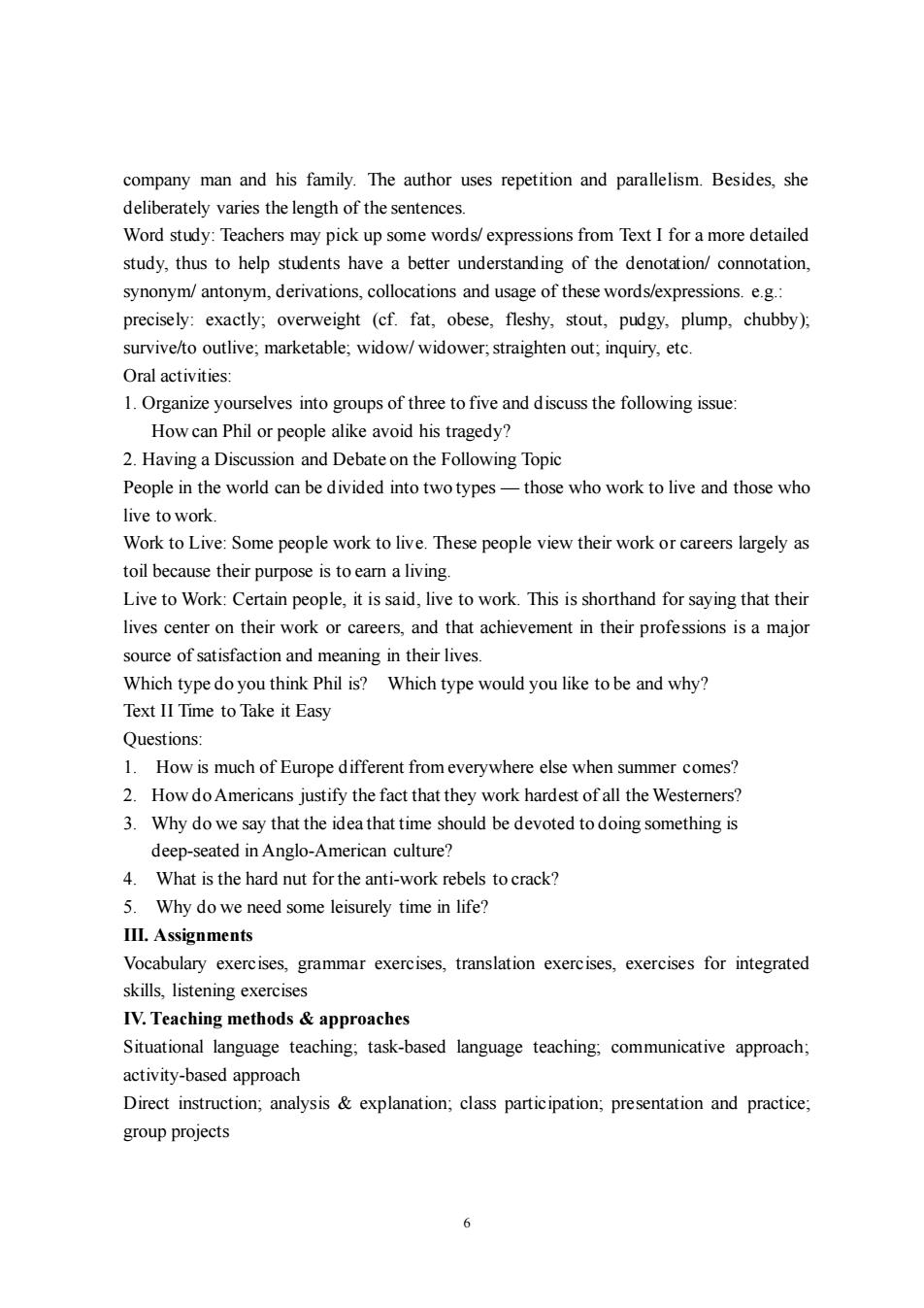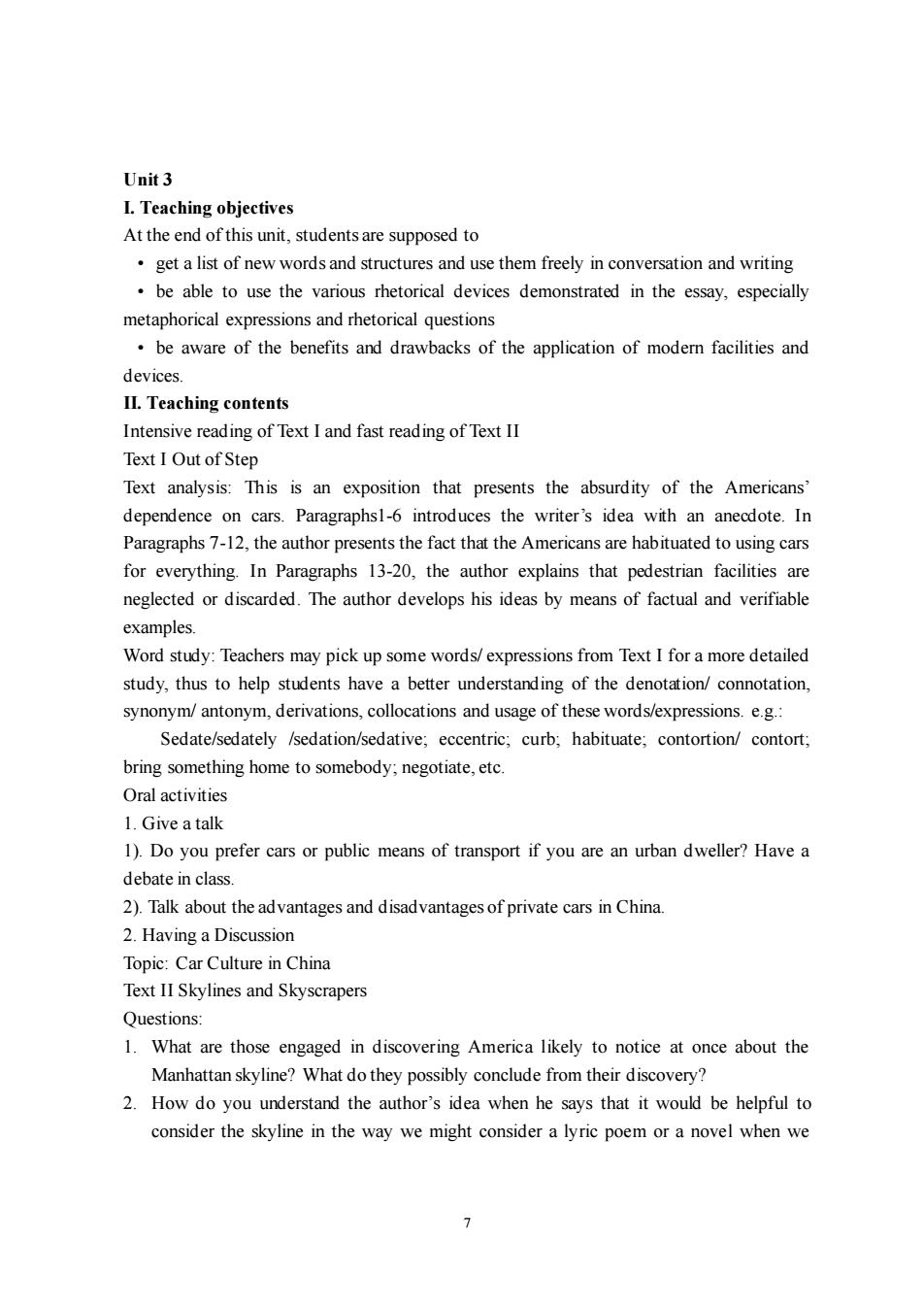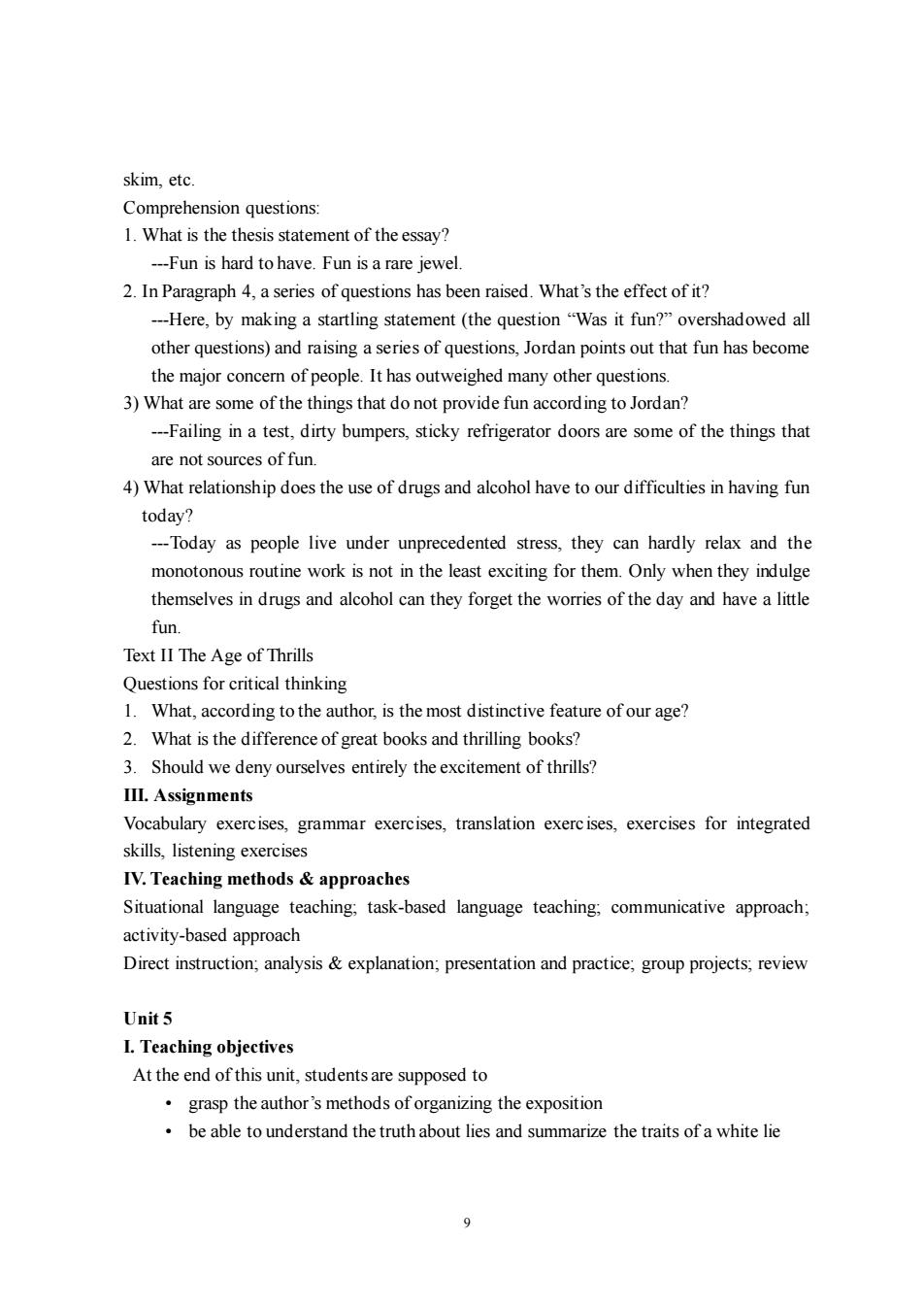
company man and his family.The author uses repetition and parallelism.Besides,she deliberately varies the length of the sentences. Word study:Teachers may pick up some words/expressions from Text I for a more detailed study,thus to help students have a better understanding of the denotation/connotation. synonym/antonym,derivations,collocations and usage of these words/expressions.e.g.: precisely:exactly;overweight (cf.fat,obese,fleshy,stout,pudgy,plump,chubby). survive/to outlive;marketable;widow/widower,straighten out;inquiry.etc. Oral activities: 1.Organize yourselves into groups of three to five and discuss the following issue How can Phil or people alike avoid his tragedy? 2.Having a Discussion and Debateon the Following Topic People in the world can be divided into two types-those who work to live and those who live to work. Work to Live:Some people work to live.These people view their work or careers largely as toil because their purpose is toeam a living. Live to Work:Certain people,it is said,live to work.This is shorthand for saying that their lives center on their work or careers,and that achievement in their professions is a majo source of satisfaction and meaning in their lives. Which typedo you think Phil is?Which type would you like to be and why? Text II Time to Take it Easy Questions 1.How is much of Europe different fromeverywhere else when summer comes? 2.How doAmericans justify the fact that they work hardest ofall the Westemers? 3.Why do we say that the idea that time should be devoted to doing something is deep-seated in Anglo-American culture? 4.What is the hard nut for the anti-work rebels to crack? 5.Why do we need some leisurely time in life? III.Assignments Vocabulary exercises,grammar exercises,translation exercises,exercises for integrated skills,listening exercises TV.Teaching methods approaches Situational language teaching task-based language teaching communicative approach. activity-based approach Direct instruction;analysis explanation:class participation;presentation and practice group projects 6
6 company man and his family. The author uses repetition and parallelism. Besides, she deliberately varies the length of the sentences. Word study: Teachers may pick up some words/ expressions from Text I for a more detailed study, thus to help students have a better understanding of the denotation/ connotation, synonym/ antonym, derivations, collocations and usage of these words/expressions. e.g.: precisely: exactly; overweight (cf. fat, obese, fleshy, stout, pudgy, plump, chubby); survive/to outlive; marketable; widow/ widower; straighten out; inquiry, etc. Oral activities: 1. Organize yourselves into groups of three to five and discuss the following issue: How can Phil or people alike avoid his tragedy? 2. Having a Discussion and Debate on the Following Topic People in the world can be divided into two types — those who work to live and those who live to work. Work to Live: Some people work to live. These people view their work or careers largely as toil because their purpose is to earn a living. Live to Work: Certain people, it is said, live to work. This is shorthand for saying that their lives center on their work or careers, and that achievement in their professions is a major source of satisfaction and meaning in their lives. Which type do you think Phil is? Which type would you like to be and why? Text II Time to Take it Easy Questions: 1. How is much of Europe different from everywhere else when summer comes? 2. How do Americans justify the fact that they work hardest of all the Westerners? 3. Why do we say that the idea that time should be devoted to doing something is deep-seated in Anglo-American culture? 4. What is the hard nut for the anti-work rebels to crack? 5. Why do we need some leisurely time in life? III. Assignments Vocabulary exercises, grammar exercises, translation exercises, exercises for integrated skills, listening exercises IV. Teaching methods & approaches Situational language teaching; task-based language teaching; communicative approach; activity-based approach Direct instruction; analysis & explanation; class participation; presentation and practice; group projects

Unit3 I.Teaching objectives At the end of this unit,studentsare supposed to get a list of new words and structures and use them freely in conversation and writing be able to use the various rhetorical devices demonstrated in the essay,especially metaphorical expressions and rhetorical questions be aware of the benefits and drawbacks of the application of modem facilities and devices. II.Teaching contents Intensive reading of Text I and fast reading of Text II Text I Out of Step Text analysis:This is an exposition that presents the absurdity of the Americans' dependence on cars.introduces the writer's idea with an anecdote.In Paragraphs 7-12,the author presents the fact that the Americans are habituated to using cars for everything.In Paragraphs 13-20,the author explains that pedestrian facilities are neglected or discarded.The author develops his ideas by means of factual and verifiable examples. Word study:Teachers may pick up some words/expressions from Text I for a more detailed study,thus to help students have a better understanding of the denotation/connotation synonym/antonym,derivations,collocations and usage of these words/expressions.e.g.: Sedate/sedately /sedation/sedative::habituate:contortion/contort bring something home to somebody;negotiate,etc. Oral activities 1.Give a talk 1).Do you prefer cars or public means of transport if you are an urban dweller?Have a debate in class 2).Talk about the advantages and disadvantagesof private cars in China 2.Having a Discussion Topic:Car Culture in China Text II Skylines and Skyscrapers Questions: 1.What are those engaged in discovering America likely to notice at once about the Manhattan skyline?What do they possibly conclude from their discovery? 2.How do you understand the author's idea when he says that it would be helpful to consider the skyline in the way we might consider a lyric poem or a novel when we 7
7 Unit 3 I. Teaching objectives At the end of this unit, students are supposed to • get a list of new words and structures and use them freely in conversation and writing • be able to use the various rhetorical devices demonstrated in the essay, especially metaphorical expressions and rhetorical questions • be aware of the benefits and drawbacks of the application of modern facilities and devices. II. Teaching contents Intensive reading of Text I and fast reading of Text II Text I Out of Step Text analysis: This is an exposition that presents the absurdity of the Americans’ dependence on cars. Paragraphs1-6 introduces the writer’s idea with an anecdote. In Paragraphs 7-12, the author presents the fact that the Americans are habituated to using cars for everything. In Paragraphs 13-20, the author explains that pedestrian facilities are neglected or discarded. The author develops his ideas by means of factual and verifiable examples. Word study: Teachers may pick up some words/ expressions from Text I for a more detailed study, thus to help students have a better understanding of the denotation/ connotation, synonym/ antonym, derivations, collocations and usage of these words/expressions. e.g.: Sedate/sedately /sedation/sedative; eccentric; curb; habituate; contortion/ contort; bring something home to somebody; negotiate, etc. Oral activities 1. Give a talk 1). Do you prefer cars or public means of transport if you are an urban dweller? Have a debate in class. 2). Talk about the advantages and disadvantages of private cars in China. 2. Having a Discussion Topic: Car Culture in China Text II Skylines and Skyscrapers Questions: 1. What are those engaged in discovering America likely to notice at once about the Manhattan skyline? What do they possibly conclude from their discovery? 2. How do you understand the author’s idea when he says that it would be helpful to consider the skyline in the way we might consider a lyric poem or a novel when we

analyze its aesthetic quality? 3.How could the fluid and ever-changing unity be achieved? III.Assignments Vocabulary exercises,grammar exercises,translation exercises,exercises for integrated skills,listening exercises IV.Teaching methods approaches Situational language teaching:task-based language teaching:communicative approach: activity-based approach Analysis&explanation;presentation and practice;group projects,review;in-class test& assessment Unit4 I.Teaching objectives At the end of this unit,students are supposed to be able to use the various rhetorical devices demonstrated in the essay,especially metaphorical expressions and rhetorical questions get a list of new wordsand structures and use them freely in conversation and writing grasp the author's purpose of writing and the theme of the essay II.Teaching contents Intensive reading of Text I and fast reading of Text II Text I Fun,Oh Boy.Fun.You could die from it Text analysis This essay evaluates the "fun"side of the American culture in an ironic way. Paragraphs 1-5 are the introductory part,which provide a simulative definition of"fun." Paragraphs 6-11 are the main body in which the writer gives an extended definition of it by negation.Paragraphs 12-15 are the concluding part with an anecdote that further explains what fun is. Todevelop the definition,a number of methods have been employed,among which are narration,comparison and contrast.The effective use of repetition adds a lot to the essay's strength. Word study: Teachers may pick up some words/expressions from Text I for a more detailed study thus to help students have a better understanding of the denotation/connotation,synonym/ antonym,derivations,collocations and usage of these words/expressions.e.g. Overshadow;flunk;epitome;epitomize;damper,blaspheme/to swear,scan/examine/
8 analyze its aesthetic quality? 3. How could the fluid and ever-changing unity be achieved? III. Assignments Vocabulary exercises, grammar exercises, translation exercises, exercises for integrated skills, listening exercises IV. Teaching methods & approaches Situational language teaching; task-based language teaching; communicative approach; activity-based approach Analysis & explanation; presentation and practice; group projects; review; in-class test & assessment Unit 4 I. Teaching objectives At the end of this unit, students are supposed to • be able to use the various rhetorical devices demonstrated in the essay, especially metaphorical expressions and rhetorical questions • get a list of new words and structures and use them freely in conversation and writing • grasp the author’s purpose of writing and the theme of the essay II. Teaching contents Intensive reading of Text I and fast reading of Text II Text I Fun, Oh Boy. Fun. You could die from it. Text analysis This essay evaluates the “fun” side of the American culture in an ironic way. Paragraphs 1-5 are the introductory part, which provide a simulative definition of “fun.” Paragraphs 6-11 are the main body in which the writer gives an extended definition of it by negation. Paragraphs 12-15 are the concluding part with an anecdote that further explains what fun is. To develop the definition, a number of methods have been employed, among which are narration, comparison and contrast. The effective use of repetition adds a lot to the essay’s strength. Word study: Teachers may pick up some words/ expressions from Text I for a more detailed study, thus to help students have a better understanding of the denotation/ connotation, synonym/ antonym, derivations, collocations and usage of these words/expressions. e.g.: Overshadow; flunk; epitome; epitomize; damper; blaspheme/to swear; scan/examine/

skim,etc. Comprehension questions: 1.What is the thesis statement of the essay? --Fun is hard to have.Fun is a rare jewel. 2.In Paragraph 4.a series of questions has been raised.What's the effect of it? ---Here,by making a startling statement(the question"Was it fun?"overshadowed all other questions)and raising a series of questions.Jordan points out that fun has become the major concern of people.It has outweighed many other questions. 3)What are some of the things that do not provide fun according to Jordan? ---Failing in a test,dirty bumpers,sticky refrigerator doors are some of the things that are not sources of fun. 4)What relationship does the use of drugs and alcohol have to our difficulties in having fun today? ---Today as people live under unprecedented stress,they can hardly relax and the monotonous routine work is not in the least exciting for them.Only when they indulge themselves in drugs and alcohol can they forget the worries of the day and have a little fun. Text II The Age of Thrills Questions for critical thinking 1.What,according to the author,is the most distinctive feature of our age? 2.What is the difference of great books and thrilling books? 3.Should we deny ourselves entirely the excitement of thrills? III.Assignments Vocabulary exercises,grammar exercises,translation exercises,exercises for integrated skills,listening exercises IV.Teaching methods approaches Situational language teaching:task-based language teaching:communicative approach; activity-based approach Direct instruction,analysis&explanation;presentation and practice;group projects;review Unit5 I.Teaching objectives At the end of this unit,students are supposed to grasp the author's methods of organizing the exposition be able to understand the truth about lies and summarize the traits of a white lie 9
9 skim, etc. Comprehension questions: 1. What is the thesis statement of the essay? ---Fun is hard to have. Fun is a rare jewel. 2. In Paragraph 4, a series of questions has been raised. What’s the effect of it? ---Here, by making a startling statement (the question “Was it fun?” overshadowed all other questions) and raising a series of questions, Jordan points out that fun has become the major concern of people. It has outweighed many other questions. 3) What are some of the things that do not provide fun according to Jordan? ---Failing in a test, dirty bumpers, sticky refrigerator doors are some of the things that are not sources of fun. 4) What relationship does the use of drugs and alcohol have to our difficulties in having fun today? ---Today as people live under unprecedented stress, they can hardly relax and the monotonous routine work is not in the least exciting for them. Only when they indulge themselves in drugs and alcohol can they forget the worries of the day and have a little fun. Text II The Age of Thrills Questions for critical thinking 1. What, according to the author, is the most distinctive feature of our age? 2. What is the difference of great books and thrilling books? 3. Should we deny ourselves entirely the excitement of thrills? III. Assignments Vocabulary exercises, grammar exercises, translation exercises, exercises for integrated skills, listening exercises IV. Teaching methods & approaches Situational language teaching; task-based language teaching; communicative approach; activity-based approach Direct instruction; analysis & explanation; presentation and practice; group projects; review Unit 5 I. Teaching objectives At the end of this unit, students are supposed to • grasp the author’s methods of organizing the exposition • be able to understand the truth about lies and summarize the traits of a white lie